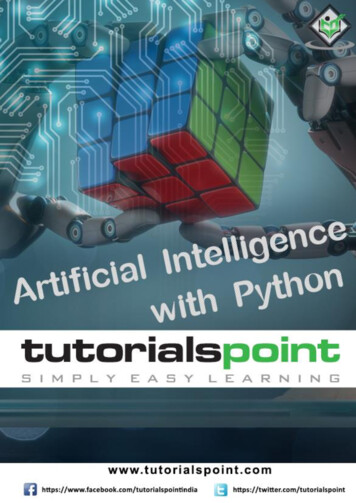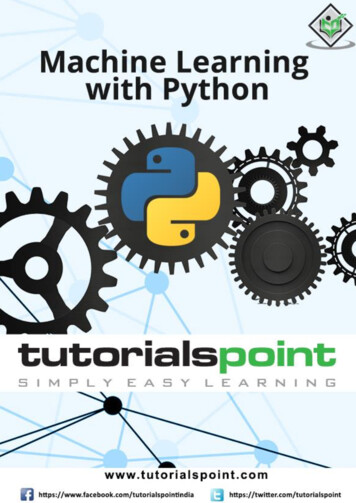
Transcription
AI with Pythonli
AI with PythonAbout the TutorialArtificial intelligence is the intelligence demonstrated by machines, in contrast to theintelligence displayed by humans.This tutorial covers the basic concepts of various fields of artificial intelligence like ArtificialNeural Networks, Natural Language Processing, Machine Learning, Deep Learning, Geneticalgorithms etc., and its implementation in Python.AudienceThis tutorial will be useful for graduates, post graduates, and research students who eitherhave an interest in this subject or have this subject as a part of their curriculum. Thereader can be a beginner or an advanced learner.PrerequisitesWe assume that the reader has basic knowledge about Artificial Intelligence and Pythonprogramming. He/she should be aware about basic terminologies used in AI along withsome useful python packages like nltk, OpenCV, pandas, OpenAI Gym, etc.Copyright & Disclaimer Copyright 2016 by Tutorials Point (I) Pvt. Ltd.All the content and graphics published in this e-book are the property of Tutorials Point (I)Pvt. Ltd. The user of this e-book is prohibited to reuse, retain, copy, distribute or republishany contents or a part of contents of this e-book in any manner without written consentof the publisher.We strive to update the contents of our website and tutorials as timely and as precisely aspossible, however, the contents may contain inaccuracies or errors. Tutorials Point (I) Pvt.Ltd. provides no guarantee regarding the accuracy, timeliness or completeness of ourwebsite or its contents including this tutorial. If you discover any errors on our website orin this tutorial, please notify us at contact@tutorialspoint.comi
AI with PythonTable of ContentsAbout the Tutorial . iAudience . iPrerequisites . iCopyright & Disclaimer . iTable of Contents . ii1.AI with Python – Primer Concepts. 1Basic Concept of Artificial Intelligence (AI) . 1The Necessity of Learning AI . 1What is Intelligence? . 2What is Intelligence Composed Of? . 3Learning l . 4What’s Involved in AI . 6Application of AI . 6Cognitive Modeling: Simulating Human Thinking Procedure . 7Agent & Environment . 82.AI with Python – Getting Started . 9Why Python for AI . 9Features of Python . 9Installing Python . 10Setting up PATH . 11Running Python . 12Script from the Command-line . 13Integrated Development Environment . 133.AI with Python – Machine Learning . 15Types of Machine Learning (ML) . 15Most Common Machine Learning Algorithms . 16ii
AI with Python4.AI with Python – Data Preparation . 20Preprocessing the Data . 20Techniques for Data Preprocessing . 21Labeling the Data . 235.AI with Python – Supervised Learning: Classification . 26Steps for Building a Classifier in Python . 26Building Classifier in Python . 29Logistic Regression . 34Decision Tree Classifier . 37Random Forest Classifier . 39Performance of a classifier . 40Class Imbalance Problem . 42Ensemble Techniques . 436.AI with Python – Supervised Learning: Regression . 44Building Regressors in Python . 447.AI with Python – Logic Programming . 49How to Solve Problems with Logic Programming. 49Installing Useful Packages . 50Examples of Logic Programming . 50Checking for Prime Numbers . 51Solving Puzzles . 528.AI with Python – Unsupervised Learning: Clustering . 55What is Clustering? . 55Algorithms for Clustering the Data . 55Measuring the Clustering Performance . 61Calculating Silhouette Score . 61Finding Nearest Neighbors . 63K-Nearest Neighbors Classifier . 65iii
AI with Python9.AI with Python – Natural Language Processing . 69Components of NLP . 69Difficulties in NLU . 69NLP Terminology . 70Steps in NLP . 7010. AI with Python – NLTK package . 72Importing NLTK . 72Downloading NLTK’s Data . 72Installing Other Necessary Packages . 73Concept of Tokenization, Stemming, and Lemmatization . 73Chunking: Dividing Data into Chunks . 75Types of chunking . 76Bag of Word (BoW) Model . 77Concept of the Statistics . 78Building a Bag of Words Model in NLTK . 79Solving Problems . 79Topic Modeling: Identifying Patterns in Text Data . 84Algorithms for Topic Modeling . 8411. AI with Python – Analyzing Time Series Data . 86Introduction . 86Installing Useful Packages . 86Pandas: Handling, Slicing and Extracting Statistic from Time Series Data . 87Extracting Statistic from Time Series Data . 91Analyzing Sequential Data by Hidden Markov Model (HMM). 95Example: Analysis of Stock Market data. 9612. AI with Python – Speech Recognition . 99Building a Speech Recognizer . 99Visualizing Audio Signals - Reading from a File and Working on it . 100iv
AI with PythonCharacterizing the Audio Signal: Transforming to Frequency Domain . 102Generating Monotone Audio Signal . 104Feature Extraction from Speech . 106Recognition of Spoken Words . 10813. AI with Python – Heuristic Search . 111Concept of Heuristic Search in AI . 111Difference between Uninformed and Informed Search . 111Real World Problem Solved by Constraint Satisfaction . 11214. AI with Python – Gaming . 115Search Algorithms . 115Combinational Search . 115Minimax Algorithm . 115Alpha-Beta Pruning. 116Negamax Algorithm . 116Building Bots to Play Games . 116A Bot to Play Last Coin Standing . 116A Bot to Play Tic Tac Toe . 11915. AI with Python – Neural Networks . 122What is Artificial Neural Networks (ANN) . 122Installing Useful Packages . 122Building Neural Networks . 122Perceptron based Classifier . 123Single - Layer Neural Networks . 124Multi-Layer Neural Networks . 12716. AI with Python – Reinforcement Learning . 131Basics of Reinforcement Learning . 131Building Blocks: Environment and Agent . 131Constructing an Environment with Python . 133v
AI with PythonConstructing a learning agent with Python . 13417. AI with Python – Genetic Algorithms . 135What are Genetic Algorithms? . 135How to Use GA for Optimization Problems? . 135Installing Necessary Packages . 136Implementing Solutions using Genetic Algorithms . 13618. AI with Python – Computer Vision . 142Computer Vision . 142Computer Vision Vs Image Processing . 142Installing Useful Packages . 143Reading, Writing and Displaying an Image . 144Color Space Conversion . 145Edge Detection . 147Face Detection . 148Eye Detection . 14919. AI with Python – Deep Learning . 151Machine Learning v/s Deep Learning . 151Convolutional Neural Network (CNN) . 151Installing Useful Python Packages . 152Building Linear Regressor using ANN . 153Image Classifier: An Application of Deep Learning . 154vi
AI with Python1. AI with Python – Primer ConceptsSince the invention of computers or machines, their capability to perform various taskshas experienced an exponential growth. Humans have developed the power of computersystems in terms of their diverse working domains, their increasing speed, and reducingsize with respect to time.A branch of Computer Science named Artificial Intelligence pursues creating thecomputers or machines as intelligent as human beings.Basic Concept of Artificial Intelligence (AI)According to the father of Artificial Intelligence, John McCarthy, it is “The science andengineering of making intelligent machines, especially intelligent computer programs”.Artificial Intelligence is a way of making a computer, a computer-controlled robot, or asoftware think intelligently, in the similar manner the intelligent humans think. AI isaccomplished by studying how human brain thinks and how humans learn, decide, andwork while trying to solve a problem, and then using the outcomes of this study as a basisof developing intelligent software and systems.While exploiting the power of the computer systems, the curiosity of human, lead him towonder, “Can a machine think and behave like humans do?”Thus, the development of AI started with the intention of creating similar intelligence inmachines that we find and regard high in humans.The Necessity of Learning AIAs we know that AI pursues creating the machines as intelligent as human beings. Thereare numerous reasons for us to study AI. The reasons are as follows:AI can learn through dataIn our daily life, we deal with huge amount of data and human brain cannot keep track ofso much data. That is why we need to automate the things. For doing automation, weneed to study AI because it can learn from data and can do the repetitive tasks withaccuracy and without tiredness.AI can teach itselfIt is very necessary that a system should teach itself because the data itself keepschanging and the knowledge which is derived from such data must be updated constantly.We can use AI to fulfill this purpose because an AI enabled system can teach itself.AI can respond in real timeArtificial intelligence with the help of neural networks can analyze the data more deeply.Due to this capability, AI can think and respond to the situations which are based on theconditions in real time.1
AI with PythonAI achieves accuracyWith the help of deep neural networks, AI can achieve tremendous accuracy. AI helps inthe field of medicine to diagnose diseases such as cancer from the MRIs of patients.AI can organize data to get most out of itThe data is an intellectual property for the systems which are using self-learningalgorithms. We need AI to index and organize the data in a way that it always gives thebest results.Understanding IntelligenceWith AI, smart systems can be built. We need to understand the concept of intelligence sothat our brain can construct another intelligence system like itself.What is Intelligence?The ability of a system to calculate, reason, perceive relationships and analogies, learnfrom experience, store and retrieve information from memory, solve problems,comprehend complex ideas, use natural language fluently, classify, generalize, and adaptnew situations.Types of IntelligenceAs described by Howard Gardner, an American developmental psychologist, Intelligencecomes in multifold:IntelligenceDescriptionExampleLinguistic intelligenceThe ability to speak, recognize, andusemechanismsofphonology(speech sounds), syntax (grammar),and semantics (meaning).Narrators, OratorsMusical intelligenceThe ability to create, communicatewith, and understand meaningsmade of sound, understanding ofpitch, icalintelligenceThe ability to use and understandrelationships in the absence of actionor objects. It is also the ability tounderstand complex and abstractideas.Mathematicians,ScientistsSpatial intelligenceThe ability to perceive visual orspatial information, change it, andre-create visual images withoutreference to the objects, construct 3DMapreaders,Astronauts,Physicists2
AI with Pythonimages, and to move and rotatethem.Bodily-KinestheticintelligenceThe ability to use complete or part ofthe body to solve problems or fashionproducts, control over fine and coarsemotor skills, and manipulate theobjects.Players, DancersIntra-personal intelligenceThe ability to distinguish among m BuddhhaInterpersonal intelligenceThe ability to recognize and makedistinctions among other people’sfeelings, beliefs, and intentions.MassCommunicators,InterviewersYou can say a machine or a system is artificially intelligent when it is equipped with atleast one or all intelligences in it.What is Intelligence Composed Of?The intelligence is intangible. It is composed of Reasoning Learning Problem Solving Perception Linguistic Intelligence3
AI with PythonLet us go through all the components briefly ReasoningIt is the set of processes that enable us to provide basis for judgement, making decisions,and prediction. There are broadly two types Inductive ReasoningIt conducts specific observations to makes broad generalstatements.Even if all of the premises are true in a statement, inductivereasoning allows for the conclusion to be false.Example "Nita is a teacher. Nita is studious. Therefore, Allteachers are studious."DeductiveReasoningIt starts with a generalstatementandexaminesthepossibilities to reach aspecific,logicalconclusion.If something is true ofa class of things ingeneral, it is also truefor all members of thatclass.Example "All womenof age above 60 yearsaregrandmothers.Shalini is 65 years.Therefore, Shalini is agrandmother."Learning lThe ability of learning is possessed by humans, particular species of animals, and AIenabled systems. Learning is categorized as follows Auditory LearningIt is learning by listening and hearing. For example, students listening to recorded audiolectures.Episodic LearningTo learn by remembering sequences of events that one has witnessed or experienced. Thisis linear and orderly.Motor LearningIt is learning by precise movement of muscles. For example, picking objects, writing, etc.4
AI with PythonObservational LearningTo learn by watching and imitating others. For example, child tries to learn by mimickingher parent.Perceptual LearningIt is learning to recognize stimuli that one has seen before. For example, identifying andclassifying objects and situations.Relational LearningIt involves learning to differentiate among various stimuli on the basis of relationalproperties, rather than absolute properties. For Example, Adding ‘little less’ salt at thetime of cooking potatoes that came up salty last time, when cooked with adding say atablespoon of salt. Spatial Learning It is learning through visual stimuli such as images, colors,maps, etc. For example, A person can create roadmap in mind before actuallyfollowing the road. Stimulus-Response Learning It is learning to perform a particular behaviorwhen a certain stimulus is present. For example, a dog raises its ear on hearingdoorbell.Problem SolvingIt is the process in which one perceives and tries to arrive at a desired solution from apresent situation by taking some path, which is blocked by known or unknown hurdles.Problem solving also includes decision making, which is the process of selecting the bestsuitable alternative out of multiple alternatives to reach the desired goal.PerceptionIt is the process of acquiring, interpreting, selecting, and organizing sensory information.Perception presumes sensing. In humans, perception is aided by sensory organs. In thedomain of AI, perception mechanism puts the data acquired by the sensors together in ameaningful manner.Linguistic IntelligenceIt is one’s ability to use, comprehend, speak, and write the verbal and written language.It is important in interpersonal communication.5
AI with PythonWhat’s Involved in AIArtificial intelligence is a vast area of study. This field of study helps in finding solutions toreal world problems.Let us now see the different fields of study within AI:Machine LearningIt is one of the most popular fields of AI. The basic concept of this filed is to make themachine learning from data as the human beings can learn from his/her experience. Itcontains learning models on the basis of which the predictions can be made on unknowndata.LogicIt is another important field of study in which mathematical logic is us
Artificial Intelligence is a way of making a computer, a computer-controlled robot, or a software think intelligently, in the similar manner the intelligent humans think. AI is accomplished by studying how human brain thinks and how humans learn, decide, and work while trying to solve a prob











